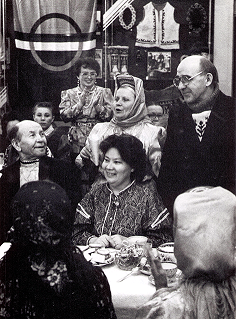Publications
On this page you will find publications that Focal Point North have contributed to.
Books and articles
 |
Lukas Allemann The Sami, the original inhabitants of Lapland, populate an area covering four nation-al states, Norway, Sweden, Finland and Russia. Their history in the twentieth century was dominated on both sides of the Iron Curtain by fateful ruptures. In this context the recent history of Russian Sami, numbering less than 2,000 and living on the Kola Peninsula, remains poorly researched. For the period after World War II, in particular, only isolated items of research exist. It is into this gap that Lukas Allemann steps. |
|
Whence Spjelkavik In modern times, certain historical landmarks in the Sulitjelma mountains have attracted visitors due to their cultural significance, or for the “feeling” of being there. The Sami people have left their mark on the mountains over the centuries, but because of a lack of records and documentation these cultural heritage sites have been erased from folklore. However, there is still one place, far off the beaten path, that is still famous today. That place is the Sara Jonas Cave, located in a secluded cliff to the west of Lake Balvatnet. |
|
|
Whence Spjelkavik The legend of a Sami shaman’s prophecy of the creation and ruin of Sulitjelma is familiar not only to those who grew up in the mining town, but also to many from far away. In particular, many remember the prediction that if a spire were to be erected on the church tower, then Sulitjelma would “go under”. A spire was never put on the church and the legend remained alive. |
|
|
Whence Spjelkavik In the southernmost outpost of the Sulitjelma mountains, high above Saltdal’s smallholdings and patches of farmland, there was a murder in 1829. The incident has not become part of local folklore, and the name of the place where the murder happened, Dieckagåhpe, has been forgotten. Even the grave of the woman who was killed is hidden in a forgotten cemetery at Saltnes in Saltdal. |
Theses
|
Lukas Kosner, Master thesis 2016 This study describes how the Finnish Orthodox Church in Sevettijärvi functions as a domain of language use and furthermore analyses what role the Church has had in the process of the Skolt Sámi language revitalization. Many researchers have expressed the importance of the Orthodox Church in everyday life of Skolt Sámi, however none have focused on the Church in the Skolt Sámi context from a sociolinguistic point of view. This study builds on the theoretical concept of domains of language use developed by Joshua Fishman and examines the Finnish Orthodox Church in Sevettijärvi as a domain of language use. |
|
|
Simon Pavall, Master thesis 2016 The Second World War had a great impact on (sic). For Norwegians, the War contributed to create a national identity, based on a shared oppression from a military invasion and resistance. Because of the war, many people fled to Sweden. Most of those refugees needed help from border pilots. In some areas Sámi border pilots was important because they knew the area very well indeed. Some of them were closely related to Sámi families in Sweden This thesis is a study what both Norwegian and Sámi border pilots did, who they were, where they did it and why they did it. It is also about how the public treated Sámi border pilots after the war. It covers the areas from Saltdal in the south to Tysfjord to the north. |
|
|
Siv Eli Vuolab, Master thesis 2016 Indigeneity is often assumed to be a rural condition, but globally, indigenous peoples are now increasingly characterized as urban populations. Research suggests that a large proportion of the Sámi population in Norway reside in urban areas and that new generations of Sámi are growing up in cities; a phenomenon coined as a geographical re-organization of Sápmi. This thesis is an investigation of some of the challenges the urban Sámi face in negotiating and maintaining a Sámi identity in two contemporary Norwegian cities |